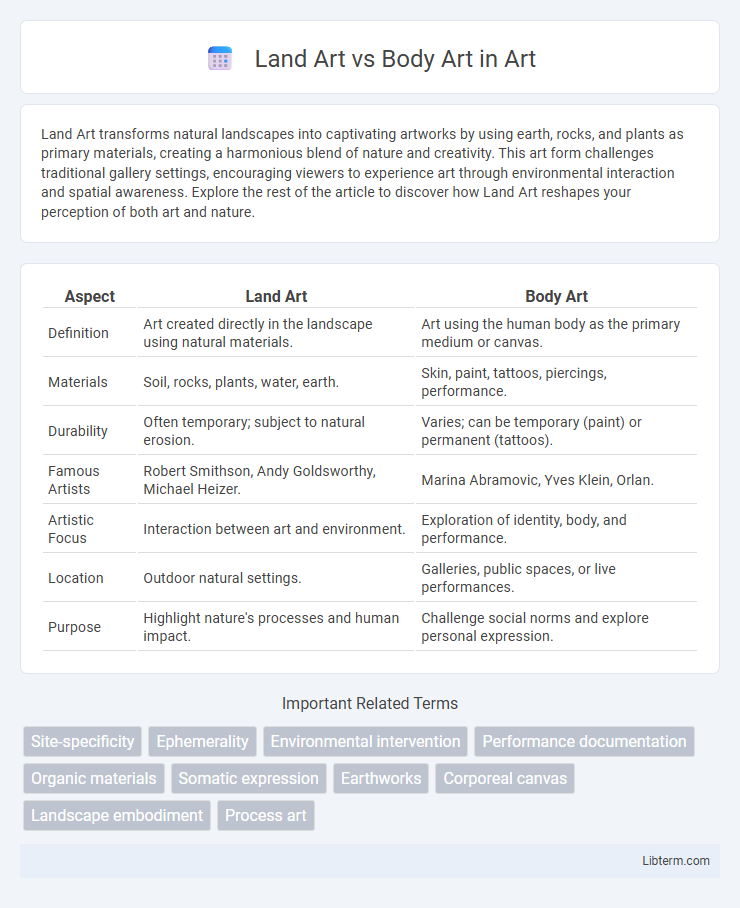Land Art transforms natural landscapes into captivating artworks by using earth, rocks, and plants as primary materials, creating a harmonious blend of nature and creativity. This art form challenges traditional gallery settings, encouraging viewers to experience art through environmental interaction and spatial awareness. Explore the rest of the article to discover how Land Art reshapes your perception of both art and nature.
Table of Comparison
| Aspect | Land Art | Body Art |
|---|---|---|
| Definition | Art created directly in the landscape using natural materials. | Art using the human body as the primary medium or canvas. |
| Materials | Soil, rocks, plants, water, earth. | Skin, paint, tattoos, piercings, performance. |
| Durability | Often temporary; subject to natural erosion. | Varies; can be temporary (paint) or permanent (tattoos). |
| Famous Artists | Robert Smithson, Andy Goldsworthy, Michael Heizer. | Marina Abramovic, Yves Klein, Orlan. |
| Artistic Focus | Interaction between art and environment. | Exploration of identity, body, and performance. |
| Location | Outdoor natural settings. | Galleries, public spaces, or live performances. |
| Purpose | Highlight nature's processes and human impact. | Challenge social norms and explore personal expression. |
Introduction to Land Art and Body Art
Land Art, emerging in the late 1960s, transforms natural landscapes into large-scale outdoor artworks, integrating earth materials like soil, rocks, and vegetation. Body Art, originating around the same period, uses the human body as both the medium and canvas, exploring identity, performance, and impermanence. These art forms challenge traditional gallery spaces by emphasizing interaction with environment or corporeal presence.
Historical Origins and Evolution
Land Art emerged in the late 1960s as an environmental movement where artists like Robert Smithson transformed natural landscapes into large-scale site-specific installations, emphasizing ecological awareness and permanence. Body Art originated in the 1960s and 1970s as a form of performance art, with pioneers such as Marina Abramovic and Chris Burden using the human body as a canvas or medium to challenge traditional art boundaries and explore personal and political themes. Both movements evolved from conceptual art roots but diverged in practice--Land Art interacting with external nature, while Body Art focuses on internal human experience and physicality.
Materials and Mediums Utilized
Land Art primarily utilizes natural materials such as soil, rocks, plants, and water, transforming expansive outdoor environments into monumental artworks. Body Art employs the human body as its primary medium, incorporating materials like paint, tattoos, piercings, and performance elements to explore identity and physical presence. Both art forms challenge traditional art boundaries by integrating unconventional materials directly tied to nature and the human experience.
Artistic Intent and Conceptual Focus
Land Art centers on transforming natural landscapes to challenge perceptions of environment and human interaction, emphasizing permanence and the relationship between art and nature. Body Art uses the human body as both a medium and subject, exploring identity, vulnerability, and the boundaries between artist and artwork. Artistic intent in Land Art often aims to create dialogue about ecological awareness, whereas Body Art focuses on personal experience and social commentary through embodied performance.
Relationship with Nature and Environment
Land Art involves creating large-scale outdoor works directly within natural landscapes, emphasizing the interplay between artistic expression and the Earth's physical features. Body Art uses the human body as the medium, often highlighting the intimate connection between personal identity and environmental elements such as skin as a living canvas. Both art forms explore the relationship with nature by either integrating external natural environments or embodying ecological themes through the human form.
Human Body as Canvas vs Natural Landscapes
Land Art transforms natural landscapes into large-scale artistic expressions by shaping earth, rocks, and vegetation to create site-specific installations that emphasize environmental interaction and temporal change. In contrast, Body Art uses the human body as a living canvas, employing techniques such as painting, tattooing, and performance to explore identity, culture, and personal narrative directly on skin surfaces. The distinction lies in scale and medium: Land Art engages with expansive environmental spaces, while Body Art focuses intimately on the contours and movements of the human form.
Temporality and Permanence in Both Art Forms
Land Art emphasizes permanence through large-scale installations intertwined with natural landscapes, yet its exposure to weather and environmental changes introduces an element of temporality. Body Art centers on the ephemeral nature of the human form, using the body as a canvas or medium subject to time, decay, and immediate experience. The contrast highlights Land Art's interaction with enduring earth materials versus Body Art's fleeting, transient existence anchored in bodily presence.
Documentation and Audience Engagement
Land Art often relies on photography, film, or drone footage to document vast, site-specific installations, enabling remote audience engagement through virtual tours and exhibitions. Body Art emphasizes real-time performance and personal interaction, with documentation frequently consisting of video recordings, photographs, and artifacts that capture ephemeral physical transformations. Audience engagement in Body Art typically involves direct presence or empathetic connection, whereas Land Art invites reflective observation mediated by visual documentation.
Key Artists and Iconic Works
Land Art is prominently represented by artists like Robert Smithson, known for the iconic "Spiral Jetty" (1970), and Nancy Holt, creator of "Sun Tunnels" (1976), both utilizing natural landscapes to create monumental earthworks. Body Art features pioneers such as Marina Abramovic, notable for "The Artist Is Present" (2010), and Yves Klein, famous for his "Anthropometry" series (1960), where the human body serves as both canvas and medium. These movements contrast through their engagement with either natural environments or the physical human form, highlighting diverse approaches to experiential and site-specific artistic expression.
Contemporary Relevance and Future Directions
Land Art emphasizes environmental engagement and large-scale natural materials, reflecting urgent ecological concerns in contemporary art. Body Art centers on personal identity and social issues by using the artist's body as a living medium, aligning with ongoing debates about autonomy and representation. Future directions suggest a fusion of both practices, integrating technology to create immersive experiences addressing climate action and human rights.
Land Art Infographic

 libterm.com
libterm.com